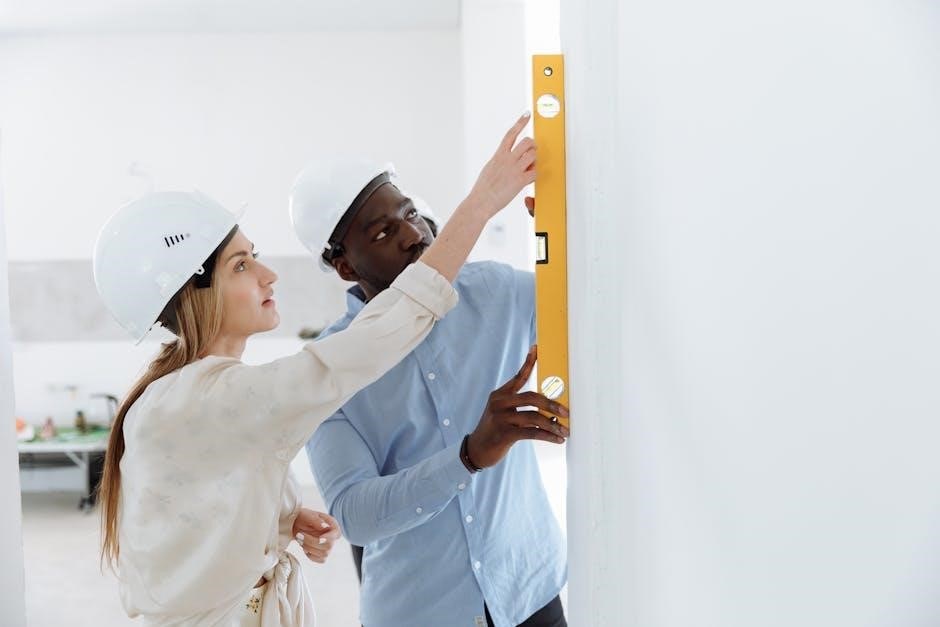
The Pentair 320 Chlorinator is an efficient, automatic feeder designed for pool sanitation, reducing manual chemical handling and ensuring consistent disinfection. It supports both chlorine and bromine tablets, providing a convenient solution for maintaining clean pool water. Compatible with various pool systems, this model offers reliable performance and ease of operation, making it a popular choice for pool owners seeking effective water treatment solutions.
Overview of the Pentair 320 Chlorinator
The Pentair 320 Chlorinator is an efficient automatic feeder designed for pool sanitation. It uses chlorine or bromine tablets to ensure consistent disinfection. Installed in the pool’s return line, it ensures even distribution of sanitizer. The feeder accepts both small and large tablets, offering flexibility for pool owners. A control valve prevents clogs and allows precise adjustment of sanitizer levels. This setup ensures optimal water quality with minimal effort, making it a reliable choice for proper pool maintenance.
Importance of the Owner’s Manual
The owner’s manual is essential for understanding the Pentair 320 Chlorinator’s operation, installation, and maintenance. It provides detailed instructions for optimizing performance, troubleshooting common issues, and ensuring safety. Reading the manual helps users grasp critical settings and procedures, preventing potential errors. Regularly referring to the guide ensures proper functionality and extends the life of the equipment, making it a vital resource for pool owners to maintain clean and safe water effectively.
Key Features of the Pentair 320 Model
The Pentair 320 Chlorinator features a completely enclosed design to prevent gas escape and includes a positive external no-clog control valve. It accommodates both large and small Trichlor or Bromine tablets, offering flexibility for pool sanitation. The feeder requires no special venting, ensuring safe and straightforward installation. Its compatibility with various pool systems and durable construction make it a reliable choice for consistent and efficient water treatment, enhancing pool maintenance with minimal effort.

Installation Instructions
Installation requires turning off all pumps and timer switches. Ensure the feeder is placed after the heater and other equipment in the return line. Follow the manual for correct plumbing connections and settings to ensure proper function and safety.
Pre-Installation Checklist
Before installing the Pentair 320 Chlorinator, ensure all pumps and timer switches are turned off. Verify the feeder’s compatibility with your pool system and ensure proper placement in the return line, after the heater and other equipment. Gather necessary tools and materials, including the provided hardware. Clean the area to avoid contamination and ensure all connections are secure to prevent leaks. Follow the manual for specific setup requirements.
Step-by-Step Installation Guide
Ensure all pumps and timer switches are off. Mount the Pentair 320 feeder vertically in the return line, after the heater and other equipment. Connect the inlet and outlet pipes securely. Open the control valve slightly and turn on the pump to check for leaks. Close the valve and fill the feeder with tablets. Recheck connections and ensure proper operation before full system startup.
Recommended Placement in Pool System
The Pentair 320 feeder should be installed in the return line of your pool system, ensuring it is placed after the heater, pool cleaner, and any valves. This placement prevents interference with other equipment and ensures optimal distribution of sanitizer. Proper positioning also avoids gas buildup and potential damage. Always follow the manufacturer’s guidelines for installation to maintain system efficiency and safety.
Operating Instructions
Turn the control valve to the desired setting, then activate the pool pump. Monitor chlorine levels daily and adjust the valve as needed to maintain optimal sanitizer levels. Regularly check the feeder’s tablet supply and ensure proper function for consistent pool sanitation.
Daily Operation and Maintenance
Daily operation involves checking the chlorine levels and ensuring the feeder is filled with tablets. Regularly inspect the control valve and internal components for proper function. Clean the O-ring and lubricate it to prevent leaks. Monitor the system’s performance and adjust settings as needed to maintain optimal sanitizer levels. This routine maintenance ensures efficient and consistent pool sanitation, extending the lifespan of the chlorinator and pool equipment.

Adjusting the Chlorine Output
To adjust the chlorine output on the Pentair 320 Chlorinator, turn the control valve to increase or decrease the flow of sanitizer. Monitor the chlorine levels in your pool and adjust the valve accordingly to maintain the recommended concentration. If using 3-inch tablets doesn’t provide enough residual chlorine, switch to 1-inch tablets for better results. Regular monitoring ensures optimal disinfection levels and prevents over-chlorination, keeping your pool water safe and clear.
Monitoring Sanitizer Levels
Regularly monitor chlorine or bromine levels in your pool water to ensure proper sanitization. Test the water daily or after heavy use, and adjust the feeder output as needed. The recommended chlorine level is 1-3 ppm, while bromine should be 3-5 ppm. If levels are too high, reduce the flow by closing the control valve slightly. The built-in check valve prevents over-chlorination when the pump is off. Always follow the manufacturer’s guidelines for optimal pool safety and clarity.
Troubleshooting Common Issues
Address issues like improper chemical levels or clogged valves by ensuring correct tablet size, cleaning the feeder regularly, and adjusting settings for optimal performance.
Identifying and Solving Common Problems
Common issues with the Pentair 320 Chlorinator include low chlorine output, clogged control valves, or improper tablet sizes. To resolve these, ensure the feeder is clean, tablets are the correct size, and valves are free of debris. Adjusting the control valve or switching to smaller tablets can often restore proper function. Regular maintenance and monitoring prevent these issues, ensuring consistent pool sanitation and system efficiency. Always refer to the manual for specific troubleshooting steps to avoid further complications and maintain optimal performance. Proper care extends the lifespan of the chlorinator and keeps your pool water safe and clean. Regular checks and prompt solutions help maintain peak functionality and prevent downtime, ensuring your pool remains a healthy and enjoyable environment year-round. By addressing problems early, you can avoid more serious issues and keep your pool system running smoothly. This proactive approach not only saves time but also reduces the need for costly repairs, making it a crucial part of overall pool maintenance. Always follow the manufacturer’s guidelines for troubleshooting to ensure safety and effectiveness, and consult the manual for detailed instructions tailored to your specific model. This will help you identify the root cause of any problem and apply the correct solution efficiently. With proper attention, the Pentair 320 Chlorinator will continue to deliver reliable performance, keeping your pool water clean and safe for everyone to enjoy. Remember, consistent upkeep is key to maintaining your investment and ensuring a pristine pool environment. By staying vigilant and addressing issues promptly, you can prevent minor problems from escalating and keep your pool system in top condition. This dedication to maintenance not only enhances your pool experience but also contributes to the longevity of your equipment, offering peace of mind and uninterrupted enjoyment of your pool. Always prioritize regular checks and timely solutions to uphold the quality and functionality of your Pentair 320 Chlorinator, ensuring it continues to serve your pool effectively for years to come.
Chemical Feeding Challenges
The Pentair 320 Chlorinator may face challenges like clogged control valves or improper chemical flow due to incorrect tablet sizes. Using dirty or irregularly shaped tablets can disrupt feeding, while excessive chlorine demand may require adjusting the feeder settings. Ensure tablets are clean, dry, and appropriately sized for optimal performance. Regularly cleaning the feeder and checking valve functionality helps prevent feeding issues. Proper chemical dosage and consistent monitoring are essential to maintain balanced pool sanitation and avoid over- or under-chlorination. Always follow the manual’s guidelines for chemical feeding to ensure smooth operation and effective pool water treatment. Regular maintenance and timely adjustments will help overcome these challenges and keep your pool water safe and clean. By addressing these issues proactively, you can ensure the Pentair 320 operates efficiently and delivers consistent results. Proper care and attention to chemical feeding practices are vital for maintaining the health and clarity of your pool water. Avoiding common pitfalls ensures your chlorinator functions as intended, providing reliable sanitation for your pool. Monitoring chemical levels and adjusting settings as needed will help prevent feeding challenges and keep your pool system running smoothly. This proactive approach not only enhances performance but also extends the lifespan of your equipment, ensuring it continues to meet your pool’s sanitation needs effectively. Regular checks and timely solutions are key to overcoming chemical feeding challenges and maintaining a pristine pool environment.
System Performance Optimization
Optimizing the Pentair 320 Chlorinator’s performance involves regular maintenance and adjustments. Ensure proper water flow by installing the feeder in the correct position in the return line. Clean the control valve and feeder chamber periodically to prevent clogs; Adjust the chlorine output based on pool usage and water test results. Monitor tablet size and type to ensure consistent feeding. Check for any blockages in the plumbing and ensure all connections are secure. Proper alignment of the feeder with the pool’s water circulation system enhances efficiency. Regularly inspect and replace worn-out parts to maintain optimal performance. By following these steps, you can ensure the chlorinator operates efficiently, providing consistent sanitation and extending its lifespan. Proper system alignment and timely adjustments are key to maximizing performance and achieving reliable pool water treatment. Consistent monitoring and proactive maintenance will help the Pentair 320 Chlorinator deliver its best results, ensuring clean and safe pool water at all times. Regular checks and optimizations will prevent issues and keep your pool system running smoothly. This approach guarantees the chlorinator functions at peak efficiency, meeting your pool’s sanitation needs effectively.
Safety Precautions
- Always wear protective gloves and eyewear when handling chlorine tablets or bromine.
- Ensure proper ventilation in the area to avoid inhaling chemical fumes.
- Prevent over-chlorination by following dosage guidelines and monitoring levels regularly.
- Keep children and pets away from the chlorinator and chemical storage areas.
- Follow emergency procedures if chemical spills or leaks occur.
Handling Chemicals Safely
When handling chlorine or bromine tablets, always wear protective gloves and eyewear to prevent skin and eye irritation. Ensure the area is well-ventilated to avoid inhaling chemical fumes. Avoid direct contact with the tablets or granules, as they can cause severe burns. Store chemicals in a cool, dry place, out of reach of children and pets. Follow the recommended dosage to prevent over-chlorination, which can harm swimmers and damage equipment. Always refer to the owner’s manual for specific safety guidelines.
Preventing Over-Chlorination
To prevent over-chlorination, always close the control valve completely when adjusting settings. Use clean, slow-dissolving chlorine or bromine tablets to ensure consistent release. Avoid overfilling the feeder, as this can lead to excessive chemical discharge. Regularly test the pool water to maintain safe sanitizer levels. If over-chlorination occurs, turn off the feeder and allow the pool to circulate until levels stabilize. Refer to the owner’s manual for specific dosage recommendations and adjustment guidelines.
Emergency Procedures
In case of an emergency, turn off the Pentair 320 Chlorinator immediately and shut down the pool equipment. Isolate the area to prevent exposure. For chemical spills, neutralize with sodium thiosulfate and flush thoroughly with water. If chlorine gas is released, ventilate the area and avoid inhalation. Seek medical attention if exposure occurs. Refer to the owner’s manual for detailed emergency response guidelines to ensure safety and proper handling of the situation.

Chemical Usage and Management
The Pentair 320 Chlorinator uses chlorine or bromine tablets for effective pool sanitation. Always use clean, slow-dissolving tablets to ensure proper operation. Avoid using dirty tablets, as they can clog the system and reduce efficiency. The feeder is compatible with both large and small tablets, providing flexibility for your pool’s specific needs.
Types of Chlorine Tablets to Use
The Pentair 320 Chlorinator is designed to use slow-dissolving chlorine or bromine tablets, such as Trichlor or Bromine tablets. These tablets provide consistent sanitization and are available in various sizes to suit your pool’s needs. Always use clean, dry tablets to ensure optimal performance and prevent clogging. The feeder’s compatibility with both large and small tablets offers flexibility. Proper tablet selection ensures efficient chlorination, maintaining clear and safe pool water.
Proper Storage and Handling
Store chlorine tablets in a cool, dry, well-ventilated area away from direct sunlight and moisture. Ensure containers are tightly sealed to prevent absorption of moisture, which can cause degradation. Handle tablets carefully, avoiding exposure to skin or eyes. Always wear protective gloves and eyewear when handling chemicals. Keep them out of reach of children and pets to ensure safety. Proper storage and handling maintain tablet effectiveness and ensure safe use with the Pentair 320 Chlorinator.
Chemical Dosage Recommendations
The Pentair 320 Chlorinator requires accurate chemical dosing to maintain optimal pool sanitation. Use 1″ or 3″ slow-dissolving chlorine or bromine tablets, depending on pool size and usage. Start with a small number of tablets and adjust based on water test results. Monitor chlorine levels regularly, aiming for 1-3 ppm for pools. Adjust the feeder’s control valve to achieve the desired residual. Proper dosing ensures effective sanitation and prevents over-chlorination, safeguarding swimmer health and system efficiency. Always follow manufacturer guidelines for best results.

Technical Specifications
The Pentair 320 Chlorinator is designed for permanent installation in pool systems, featuring durable construction and compatibility with chlorine or bromine tablets. It includes a control valve for precise chemical dosing and is built to withstand various water conditions, ensuring reliable performance and longevity in pool sanitation systems.
Design and Construction Details
The Pentair 320 Chlorinator is built with durable, high-quality materials to ensure long-lasting performance; Its large, enclosed chamber accommodates both small and large slow-dissolving chlorine or bromine tablets. The design features a positive external control valve for precise adjustment and a built-in check valve to prevent backflow. Constructed for reliability, the chlorinator is compact, rust-resistant, and designed for seamless integration into pool systems, ensuring efficient and consistent sanitation.
Compatibility with Pool Systems
The Pentair 320 Chlorinator is universally compatible with most pool systems, including new and existing installations. It can be easily integrated into the return line of your pool or spa, ensuring seamless operation with various pumps, filters, and heaters. Designed to work with both small and large chlorine or bromine tablets, this chlorinator adapts to different pool sizes and sanitation needs, making it a versatile solution for maintaining clean and safe pool water year-round.
Compliance with Safety Standards
The Pentair 320 Chlorinator adheres to rigorous safety standards, ensuring safe and efficient operation. Its design prevents gas escape, eliminating special venting requirements. Constructed with durable materials, it withstands harsh pool environments while maintaining compliance with industry regulations. This ensures user safety and reliable performance, making it a trusted choice for pool sanitation systems. Compliance with these standards guarantees peace of mind for pool owners while maintaining optimal water quality and safety.
Where to Find Additional Resources
The Pentair 320 Chlorinator is a valuable asset for efficient pool maintenance, ensuring safety and durability. Regular upkeep and consulting additional resources guarantee optimal performance and troubleshooting.